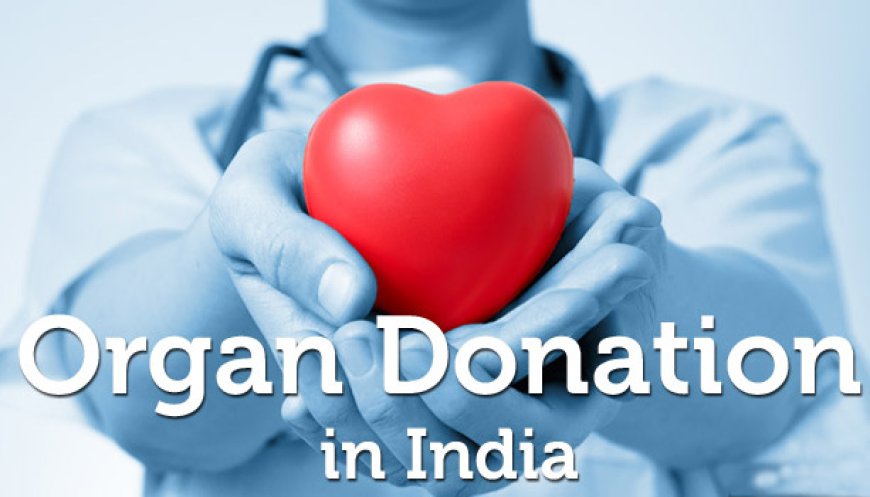People are losing their lives due to the lack of organ donation in India
One deceased organ donor can save the lives of eight people. Two donated kidneys can free two patients from dialysis treatment. A donated liver can be divided between two patients on the waiting list. Two donated lungs mean two more patients have been given a second chance, and a donated pancreas and donated heart mean two more patients have received the gift of life. A tissue donor – someone who can donate bone, tendons, cartilage, connective tissue, skin, corneas, sclera, and heart valves and vessels – can impact the lives of up to 75 people. In India, there is a need to convert the pledge of organ donation into actual donation and for this, there is a need to educate the medical staff. They must be able to recognize, recognize, inform, and counsel families about brain death and the importance of organ donation. -Dr Satyavan Saurabh

Three lakh patients are waiting for organ donation in the country and the increase in the number of donors in the country is not keeping pace with the demand; Experts say the country urgently needs to increase deceased donation rates, and there should be more awareness among ICU doctors and families about how a deceased donor can save many lives. With a waiting list of over three lakh patients and at least 20 people dying every day while waiting for an organ, the shortage of organ donation in India, especially deceased donation, is taking a huge toll. The rate of deceased organ donation in India has been less than one donor per million population for the last decade.
India needs to increase this to 65 donations per million population and to do so, public sector healthcare has to step up. There are about 600 medical colleges and more than 20 AIIMS in the country. If we get even one donation from them every year, we will be in a better situation. Even worldwide, only 10% of patients requiring organs receive them on time. Spain and the US have better organ donation systems, with donation rates of 30–50 per million. Training trauma and ICU doctors to help patients' families come forward and donate is the need of the hour, despite the availability of many potential cases, the low rate of organ donation in India is due to an insufficient number of brain death or brain stem death cases. Due to identification and authentication. In terms of organ donation, the country's annual average is still less than one donor per million people.
According to road transport statistics, every year in India, around 150,000 people die on the roads. This means that on average, more than 1000 accidents occur on the roads every day and more than 400 people die. In organ donation, the organs of a deceased donor - such as the heart, liver, kidneys, intestines, eyes, lungs, and pancreas - are removed and transplanted into the body of another person, which is required to survive. They are needed. A deceased donor, also called a cadaver, can thus save up to nine lives. However, health professionals usually feel uncomfortable talking to relatives of the deceased about the topic of organ donation. Doctors shy away from asking about donating the organs of the deceased. There is no encouragement in this regard and there is also a fear of retaliation.
The public is reluctant and distrustful because they do not fully understand the idea of brain death, organ donation, or its benefits. Cultural customs regarding the body after death may hinder consent, and some religious beliefs prohibit organ donation. India has adequate transplant centers, and Many patients with organ failure die while waiting for a transplant as a result of acute organ shortage. The overwhelming need for organs leads to illegal organ trade networks, which expose vulnerable people to ethical and health issues as well as exploitation. Puts you in danger. Health disparities are exacerbated by the limited supply of organs, making them more likely for those with money. Receive a life-saving transplant. Dialysis and other supportive care are among the many resources that are heavily taxed by the task of managing patients with end-stage organ failure.
All things considered, India's healthcare system suffers greatly from low organ donation rates, resulting in avoidable deaths, unethical practices, and unequal access to life-saving care. To ensure that everyone has fair access to organ transplantation, addressing these issues requires a multifaceted strategy that includes ethical considerations, legal reform, infrastructure development, and public education. One deceased organ donor can save the lives of eight people. Two donated kidneys can free two patients from dialysis treatment.
A donated liver can be divided between two patients on the waiting list. Two donated lungs mean two more patients have been given a second chance, and a donated pancreas and donated heart mean two more patients have received the gift of life. A tissue donor – someone who can donate bone, tendons, cartilage, connective tissue, skin, cornea, sclera, and heart valves and vessels. Can affect the lives of 75 people. In India, there is a need to convert the pledge of organ donation into actual donation and for this, there is a need to educate the medical staff. They must be able to recognize, recognize, inform, and counsel families about brain death and the importance of organ donation.

 Yash Saini
Yash Saini 





